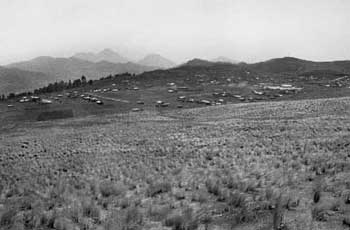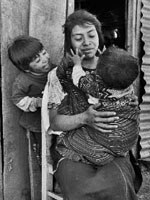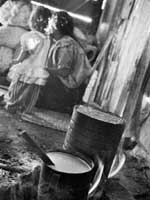|
July 21, 2005
Doctors without Borders - Water for Ixtahuacan
Just yesterday I completed an interview with Doctors
Without Borders/ Médécins Sans Frontières
(MSF) and while researching their website, I found that some of
the volunteers at MSF
had written really interesting stories about their experiences in
foreign countries. MSF gave me the permission to republish some
of these stories, I think you'll find them very interesting since
they shed light on the situation of the local population and the
experiences of the volunteers in some of these far away places.
Water for Ixtahuacan
By Chris Osler
As I scrambled up the embankment of the new road, my right
foot sank into the furrow of earth plowed up by graters and other
heavy machinery. To my amazement, this experience was like cutting
across a wintery street in Canada, when the snow is piled along
the curbs and sidewalks of our cities, and sinking into the snow.
The difference here, however, was that this was extremely thick,
dry dust and this was not Canada but one of the highest points in
Guatemala — the new village of Santa Catarina Ixtahuacan.

Coming over the crest of the hill, Ixtahuacan appeared as a cluster
of corrugated tin shacks and small cinderblock houses. Immediately
I was struck by the dust: a thick layer of powdery dust, like brown
icing sugar, blew into my eyes and nose. Swirling Dust Devils spun
across the tiny valley, twisting debris far up into the sky. After
a day in Ixtahuacan, I could feel the parched resistance of my throat
and lungs. After only a few hours here, visitors usually want to
leave; but for more than 550 families, this desolate place is home.
There is a buzz of activity in this construction site of a village.
Everywhere you turn, people are busily tending to their homes, molding
mud bricks, and pouring concrete. It seems difficult to imagine
that just six weeks before my visit in February 2000, there were
no buildings at all, only dusty fields and the crusty stalks of
last years' corn crop. This is the relocated town of Ixtahuacan,
an impoverished gathering of 2800 stoic Guatemalans who continue
to fight against a barrage of obstacles in their lives. As a documentary
photographer and development worker, I had come to Guatemala to
record the story of these people and their difficult decision to
move the town. Happily, I found that several NGOs, most notably
MSF, had begun to assist the community with their basic needs.

Daily life for the people of Ixtahuacan is a struggle for survival.
Behind the superficial beauty of this Central American region, lie
both a political uncertainty and a string of bubbling volcanoes.
Over the past few years, frequent tremors have led many seismic
experts to label the old village of Ixtahuacan a "category
orange" danger site. When Hurricane Mitch hit the area in November
of 1998, dumping up to six feet of rain in only three days, it ravaged
the steep slopes, sending torrential rivers of mud through about
one-third of the town. Two people lost their lives during this crisis,
and many houses were damaged or washed away completely. During the
aftermath of the devastating storm, the leaders of the community
met to discuss possible locations that would prove safer from future
environmental disasters. On January 11th, 2000, the people of Santa
Catarina Ixtahuacan packed up their belongings, salvaged what pieces
of their homes they could transport, and traveled fifteen kilometres
to the site of their new village.
The new site of Ixtahuacan, nicknamed "Alaska" because
of its regular morning frost and its bleak arctic landscape, sits
within a stone's throw of the highest point on the Inter-American
Highway at 3670 metres. Nights are cold and mornings brisk. Weather
changes quickly here and bright warm sun can disappear in minutes
when the fog drifts in. The tree-less exposure at the top of this
volcanic mountain range leaves the bowl-shaped site of Ixtahuacan
vulnerable to wind.
When asked why they wanted to move to a place with no surrounding
farmland, firewood or available clean water, most people replied
that after years of rebuilding their houses from tremors, they feel
safer in "Alaska" despite the difficulties. Catarina Salame
Mas, a Quiche Mayan woman, has eleven children. Despite her struggle
to feed and cloth her family in the new village site, she is relieved
to no longer be fearful for their lives. During the downpour of
Hurricane Mitch, the foundation of their water tower was quickly
eroded and the tower crashed through their roof. Fortunately, the
family managed to wade through the mud to the safety of a neighbour’s
house. In the new community, she is no longer afraid for her family.

In addition to the increased safety and psychological relief, many
younger men also noted the "advantages" of the new town
site’s proximity to the main highway, and therefore, to the
frequency of cars and buses. Xela, the second largest city of Guatemala,
is now only one hour away.
Due to extremely harsh economic circumstances, most of the village's
dark and dusty one-room shacks are used for everything from sleeping
to cooking. When a wood-fire is burning to cook food or to heat
water, the smoke billows out and saturates the room, filling the
homes and lungs of the inhabitants. Since women and children are
usually responsible for these daily chores, they are disproportionately
affected. Respiratory problems, conjunctivitis, and various other
eye irritations are common. Until the arrival of MSF, the lack of
available clean water was the biggest concern.
MSF France, MSF Spain, and MSF Switzerland are all working in Guatemala.
Under the direction of MSF Spain, Ixtahuacan received perhaps the
greatest assistance of all — a potable water supply system.
As the community is almost flat and it is high in elevation, there
are only tiny trickling streams. MSF drilled two wells which run
into a central cistern at the lowest point of the village. They
then set up a diesel pump to fill two "inflatable" emergency
water bladders up higher, closer to the houses. These bladders,
which can hold 15 000 litres each, flow by gravity to six-way taps
where the people of Ixtahuacan collect clean water. Local resident
Miguel Angel was trained by MSF to maintain the water supply system,
run the diesel pump, and add chlorine to the water bladders. Now
MSF visits the site every couple of weeks to check that all is running
smoothly.

The water supply bladders installed by MSF have made a huge impact
on the people of Ixtahuacan. Now they are able to access clean water
at nearby taps, without facing the health risks probable when collecting
water from stagnant pools, walking kilometres to surrounding rivers,
or wasting valuable firewood boiling water for drinking and cooking.
With water resources now available, the community can begin to
direct their energy towards other struggles facing them —
proper housing, nutritious food, farming, wage labour, etc.
By Chris Osler
www.msf.ca
Related Articles:
Read my interview with Doctors
without Borders
Doctors without Borders: Visiting
an Afghan Refugee Camp
Doctors without Borders: El Salvador,
after the Earthquake
Doctors without Borders: Water
for Ixtahuacan
Doctors without Borders: Visiting
MSF in Sierra Leone
Doctors without Borders: Lost between River
and Sky
Doctors without Borders: Journey
into the World of Humanitarian Aid
|